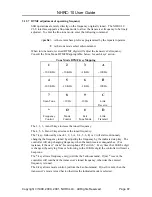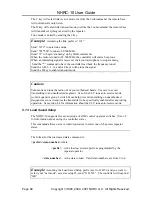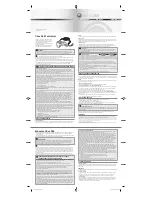
NHRC-10 User Guide
Page 54
Copyright
1999, 2000, 2001 NHRC LLC. All Rights Reserved.
5.4 Emergency Autodial
The NHRC-10 Repeater Controller supports 10 emergency autodial memory locations, or
“slots.” The repeater operator can program the slots with the *5 command. See section
3.5 for information on programming the autodial slots.
Users can make emergency telephone calls to the pre-assigned emergency autodial slots
with the following command:
<prefix><slot-number>
where:
<prefix>
is the autodial prefix as programmed by the repeater
operator, described in Section 3.5 of this manual.
<slot-number>
is the emergency autodial slot number to dial. The valid
range for autodial slot number is 0-9.
Example:
if the emergency autodial prefix is set to 12, to call the number stored in
emergency autodial slot #6, send the following command: "126". If a phone number is
stored in that slot, then the controller will say "emergency autodial six", and the call will
be placed. If the specified slot is not programmed, then NO ERROR MESSAGE WILL
BE PLAYED.
5.5 Patch Hang Up Code
The NHRC-10 Autopatch Hang-up Code is programmable to prevent miscreants from
using the default “#” to hang up user’s telephone calls.
Whether the hang-up code is the default “#”, or changed to some other prefix, the use is
the same:
<prefix>
where:
<prefix>
is the hang-up prefix as programmed by the repeater operator,
described in Section 3.5 of this manual.
Example:
To hang up the patch if the patch hang up code is "#", send "#". To hang
up the patch if the patch hang up code is 4321, then send "4321".
















































